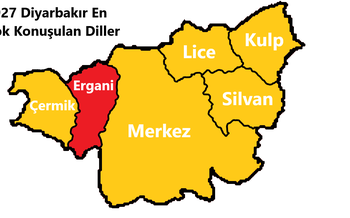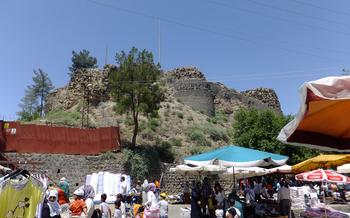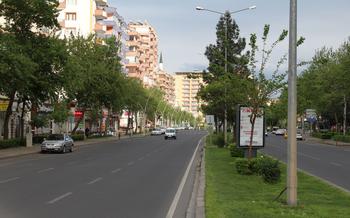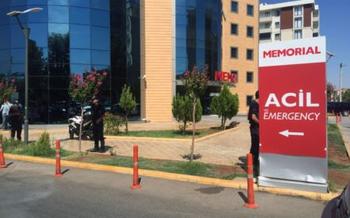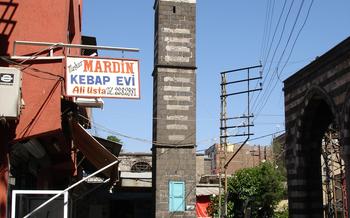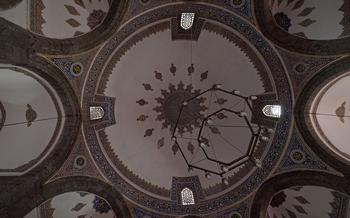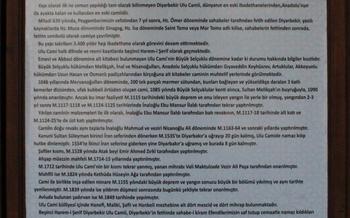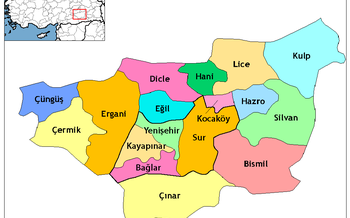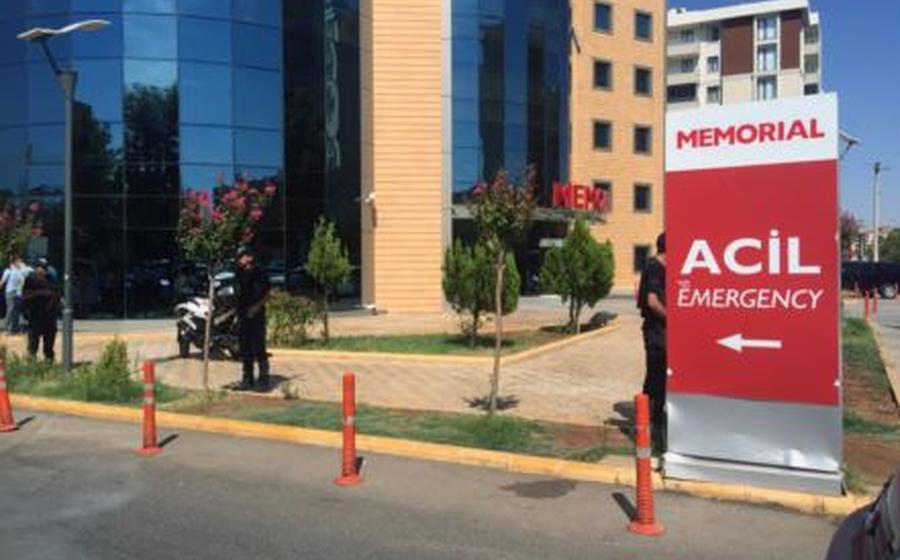
Kufa Mosque
- Historical Significance
- Location and Accessibility
- Architectural Highlights
- Interior Beauty
- Religious Significance and Practices
- Tips for Visitors
- Nearby Attractions
- Local Cuisine and Delights
- Shopping and Handicrafts
- Festivals and Events
- Accommodations and Hotels
- Safety and Security
- Language and Communication
- Insider Tip: The Hidden Treasure of the Kufa Mosque
Historical Significance
The Kufa Mosque stands as a testament to the rich Islamic heritage of Diyarbakır, dating back to the 7th century during the Arab conquest of the region. It is believed to have been built by the Arab commander, Iyad ibn Ghanm, in 639 AD, making it one of the oldest mosques in Turkey. Throughout history, the Kufa Mosque has served as a prominent religious center and place of worship for Muslims in the region. Its architectural and historical significance make it an exceptional example of early Islamic architecture, showcasing unique features such as its octagonal shape and the inscriptions that adorn its walls. The mosque has undergone several renovations and expansions over the centuries, reflecting the evolving architectural styles and influences that have shaped Diyarbakır's built environment.
Location and Accessibility
The Kufa Mosque stands tall in the heart of Diyarbakır, a city steeped in history and cultural heritage. To reach this architectural marvel, visitors can embark on a scenic journey through the city's vibrant streets. Public transportation offers a convenient and affordable option, with buses and trams connecting various parts of Diyarbakır to the mosque's vicinity.
For those who prefer the flexibility of self-driving, the mosque is easily accessible by car. Ample parking facilities are available in the surrounding area, ensuring a hassle-free visit.
To fully immerse in the mosque's serene atmosphere, it is recommended to choose a time outside of the peak prayer hours. This allows for a peaceful exploration of the mosque's intricate details and a deeper connection with its spiritual essence.
Architectural Highlights
The Kufa Mosque stands out for its unique octagonal shape, a distinctive feature that sets it apart from many other mosques. Constructed using local limestone, the mosque showcases the skill and expertise of early Islamic builders. The exterior walls are adorned with intricate carvings and inscriptions in Kufic script, providing a glimpse into the artistic and cultural traditions of the period.
The mosque's most striking feature is its octagonal minaret, which rises gracefully from the northeastern corner. The minaret's slender form and intricate brickwork exemplify the innovative architectural techniques employed by early Islamic builders. The dome, situated atop the prayer hall, adds to the mosque's grandeur and provides a sense of spaciousness to the interior.
Inside, the prayer hall is divided into eight sections, each corresponding to one side of the octagonal shape. The mihrab, the niche indicating the direction of Mecca, is intricately carved and decorated with colorful tiles, highlighting its importance as the focal point of the mosque. The minbar, the elevated platform used by the imam to deliver sermons, is also exquisitely crafted, showcasing the mosque's attention to detail and artistic expression.
Interior Beauty
The interior of the Kufa Mosque exudes an atmosphere of serenity and spirituality, inviting visitors to immerse themselves in its sacred space. The walls are adorned with intricate calligraphy, verses from the Quran, and geometric patterns that create a visually stunning tapestry. The mihrab, a niche indicating the direction of Mecca, is particularly impressive, featuring intricate carvings and colorful tiles that draw the eye. The minbar, or pulpit, is another notable feature, showcasing fine woodwork and intricate designs. The overall effect is one of awe-inspiring beauty and reverence, creating a conducive environment for prayer and contemplation.
In my personal experience, I was struck by the palpable sense of peace and tranquility within the mosque. The soft light filtering through the stained-glass windows cast a warm glow on the intricate decorations, creating a truly mesmerizing sight. It was easy to understand why this mosque holds such a special place in the hearts of Diyarbakır's Muslim community.
Religious Significance and Practices
The Kufa Mosque holds immense religious significance as a cherished place of worship for Muslims in Diyarbakır. Throughout history, it has served as a central hub for religious practices and spiritual gatherings. Today, the mosque continues to be a vibrant center for daily prayers, where the faithful congregate to offer their devotions and seek spiritual solace.
Beyond its role as a place of worship, the Kufa Mosque is also a hub for Islamic learning and education. It hosts religious classes, lectures, and seminars, fostering a deep understanding of Islamic teachings and traditions among the community members. The mosque's serene atmosphere provides an ideal setting for contemplation, study, and spiritual growth.
Visitors to the Kufa Mosque are encouraged to observe the customs and traditions associated with visiting a sacred religious space. This includes removing shoes before entering the prayer hall, dressing modestly, and maintaining a respectful demeanor. By adhering to these customs, visitors can show their respect for the sanctity of the mosque and contribute to the harmonious atmosphere. The spiritual significance of the Kufa Mosque extends far beyond its physical structure, touching the hearts and minds of those who seek guidance, peace, and connection with the divine.
Tips for Visitors
When visiting the Kufa Mosque, it is important to be respectful of the religious customs and traditions practiced within. Visitors should dress modestly, covering their shoulders and knees, and remove their shoes before entering the mosque. It is also important to be mindful of noise levels and avoid disturbing those who are praying or attending religious services. Guided tours of the mosque are available, which can provide visitors with a deeper understanding of its history, architecture, and significance. Photography is permitted within the mosque, but it is important to be respectful and avoid taking photos of people without their permission.
Nearby Attractions
The Kufa Mosque is surrounded by a treasure trove of historical and cultural attractions that offer visitors a glimpse into the rich heritage of Diyarbakır. Just a short walk away, visitors can explore the impressive Diyarbakır Fortress, a UNESCO World Heritage Site that dates back to the Roman Empire and offers stunning panoramic views of the city. The captivating İçkale, the inner citadel of the fortress, houses several significant landmarks, including the Ulu Mosque, the Great Mosque of Diyarbakır, which is renowned for its architectural beauty and historical significance.
For those interested in art and history, the Diyarbakır Museum is a must-visit. The museum houses a vast collection of artifacts, including ancient sculptures, pottery, and manuscripts, that provide a glimpse into the region's rich cultural past. The museum's Islamic art collection is particularly noteworthy, showcasing intricate calligraphy, tilework, and other decorative elements that adorn the city's mosques and religious buildings.
Visitors can also immerse themselves in the vibrant local culture by exploring the bustling bazaars and markets of Diyarbakır. The Coppersmiths' Bazaar, renowned for its skilled artisans who create intricate copperware, is a feast for the senses. The colorful textiles, spices, and local delicacies on display at the Yenişehir Bazaar offer a glimpse into the daily life and traditions of the city's residents.
Local Cuisine and Delights
Diyarbakır's culinary heritage is as rich and diverse as its history, boasting a delectable blend of Turkish, Kurdish, and Arabic influences. Savor the aromatic flavors of traditional dishes like "mırra," a hearty lamb stew slow-cooked in a clay pot, or "çığırtma," a tantalizing combination of lamb, vegetables, and yogurt. Indulge in the crispy layers of "lavaş," a flatbread baked in traditional ovens, and pair it with dips like "ezme," a spicy tomato-pepper relish, or "hummus," a creamy chickpea spread.
Don't miss the chance to try "kaburga dolması," succulent lamb chops stuffed with rice, pine nuts, and herbs, or "içli köfte," savory bulgur dumplings filled with minced meat and spices. For a sweet treat, delight in "kadayıf," shredded filo dough filled with nuts and sweetened syrup, or "künefe," a cheese-based dessert topped with crispy shredded dough and drizzled with syrup.
Explore the vibrant markets of Diyarbakır to discover an array of local delicacies, including fresh fruits, vegetables, spices, and traditional sweets. Engage with friendly vendors and immerse yourself in the lively atmosphere as you bargain for the best prices. Savor the authentic flavors of Diyarbakır's cuisine, a testament to the city's rich cultural tapestry.
Shopping and Handicrafts
Diyarbakır is renowned for its vibrant shopping scene and exquisite traditional handicrafts. Visitors can immerse themselves in the bustling bazaars and markets, where they can find a treasure trove of unique souvenirs and local products. One must-visit destination is the historic Coppersmiths' Bazaar, where skilled artisans showcase their mastery in crafting intricate copperware, from decorative trays to ornate coffee pots. The city is also famous for its high-quality textiles, including intricately woven carpets, embroidered fabrics, and traditional Kurdish attire. Visitors can find an array of these beautiful textiles in shops and boutiques throughout the city. Whether you're looking for a unique piece of jewelry, a handmade carpet, or a traditional souvenir, Diyarbakır offers an unforgettable shopping experience that celebrates the city's rich cultural heritage.
Festivals and Events
Diyarbakır is renowned for its vibrant festivals and events that showcase its rich cultural heritage and Islamic traditions. The city comes alive during the annual Diyarbakır Culture and Art Festival, held in May or June, which features a myriad of cultural performances, exhibitions, and workshops. Visitors can immerse themselves in traditional music, dance, theater, and art, gaining a deeper understanding of the region's diverse cultural tapestry.
Another significant event is the Mawlid al-Nabi, also known as the Prophet's Birthday, which commemorates the birth of Prophet Muhammad. During this time, the Kufa Mosque becomes the focal point of celebrations, with special prayers, recitations, and gatherings held to honor the Prophet's life and teachings.
To coincide with the spiritual significance of the Kufa Mosque, the city also hosts the Diyarbakır Islamic Culture Festival. This festival gathers renowned Islamic scholars, artists, and intellectuals from around the world to engage in discussions, workshops, and exhibitions that explore Islamic history, philosophy, and contemporary issues.
For those seeking a unique and immersive experience, the Diyarbakır Ramadan Bazaar is a must-visit. Held during the holy month of Ramadan, this vibrant bazaar offers a delightful array of traditional Turkish and Kurdish delicacies, handmade crafts, and cultural performances. Visitors can savor the flavors of local cuisine, witness traditional dances, and soak up the festive atmosphere of this special time.
Accommodations and Hotels
When planning your stay in Diyarbakır, you'll find a range of accommodation options to suit different budgets and preferences. For an immersive experience, consider staying in one of the traditional guesthouses or boutique hotels located within the historic center. These charming establishments often feature authentic architecture, cozy rooms, and rooftop terraces with panoramic views of the city.
If you prefer modern amenities and international standards, several reputable hotels are situated near the Kufa Mosque. These hotels offer a comfortable and convenient stay, with facilities such as fitness centers, swimming pools, and business centers.
To find the best deals and availability, it's advisable to book your accommodation in advance, especially during peak tourist seasons. Online booking platforms and travel agents can provide a wide range of options and discounts.
Here are some specific recommendations:
- For a luxurious stay with stunning city views, consider the Divan Diyarbakır Hotel, located just a short walk from the Kufa Mosque.
- For a more budget-friendly option, the Grand Park Diyarbakır Hotel offers comfortable rooms and a central location.
- For a unique and authentic experience, try the Suruç Han, a restored historical caravanserai that offers traditional Turkish hospitality and charm.
No matter your choice of accommodation, you'll find that Diyarbakır's hotels and guesthouses are committed to providing a safe and enjoyable stay for all visitors.
Safety and Security
Diyarbakır has experienced periods of unrest and conflict in the past, but the city has made significant progress in recent years to ensure the safety of tourists and visitors. Local authorities have implemented various measures to enhance security, including increased police presence, surveillance cameras, and improved infrastructure. While it's essential to be aware of your surroundings and take precautions, Diyarbakır is generally considered a safe city for travelers. To ensure a smooth and enjoyable visit, avoid isolated areas at night, respect local customs and traditions, and be mindful of any potential language barriers.
Language and Communication
Diyarbakır is a culturally diverse city where Turkish and Kurdish are the primary languages spoken. While many locals may have some understanding of English, it's not as widely spoken as in other tourist destinations. To communicate effectively, it's helpful to learn a few basic phrases in Turkish or Kurdish, such as greetings, thank you, and directions. Translation apps can also be useful, but keep in mind that they may not always be accurate.
Don't be afraid to use gestures, body language, or visual aids to overcome language barriers. Locals are generally friendly and welcoming, and they'll appreciate your effort to communicate with them.
I once had a memorable experience while trying to find directions to the Kufa Mosque. I approached a group of elderly men sitting at a local teahouse and asked for help in Turkish. Despite their limited English, they went out of their way to explain the route, using hand gestures and a map drawn on a napkin. It was a heartwarming moment that showed me the kindness and hospitality of the local people.
Insider Tip: The Hidden Treasure of the Kufa Mosque
Beyond its architectural marvels and religious significance, the Kufa Mosque holds a hidden gem that often goes unnoticed by visitors. Within the mosque's courtyard, nestled amidst the serene atmosphere, lies a centuries-old olive tree. This majestic tree, with its gnarled trunk and lush foliage, is believed to be over 700 years old, silently witnessing the passage of time and the countless prayers offered within the mosque's walls. Take a moment to pause beneath its ancient branches, soak in its tranquil energy, and reflect on the rich history and spiritual essence that permeate this sacred space.
